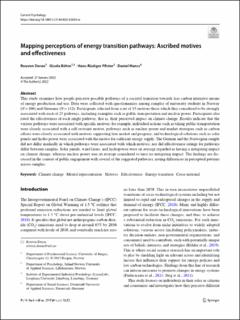| dc.description.abstract | This study examines how people perceive possible pathways of a societal transition towards less carbon intensive means of energy production and use. Data were collected with questionnaires among samples of university students in Norway (N = 106) and Germany (N = 142). Participants selected from a set of 15 motives those which they considered to be strongly associated with each of 25 pathways, including examples such as public transportation and nuclear power. Participants also rated the effectiveness of each single pathway, that is, their perceived impact on climate change. Results indicate that the various pathways were associated with specific motives; for example, individual actions such as taking public transportation were closely associated with a self-restraint motive, pathways such as nuclear power and market strategies such as carbon offsets were closely associated with motives supporting free market and progress, and technological solutions such as solar panels and hydro power were associated with the motive for sufficient energy supply. The German and the Norwegian sample did not differ markedly in which pathways were associated with which motives; nor did effectiveness ratings for pathways differ between samples. Solar panels, wind farms, and hydropower were on average regarded as having a mitigating impact on climate change, whereas nuclear power was on average considered to have no mitigating impact. The findings are discussed in the context of public engagement with several of the suggested pathways, noting differences in perceptual patterns across samples. | en_US |

